GUCCI英文简介
- 格式:doc
- 大小:603.50 KB
- 文档页数:6
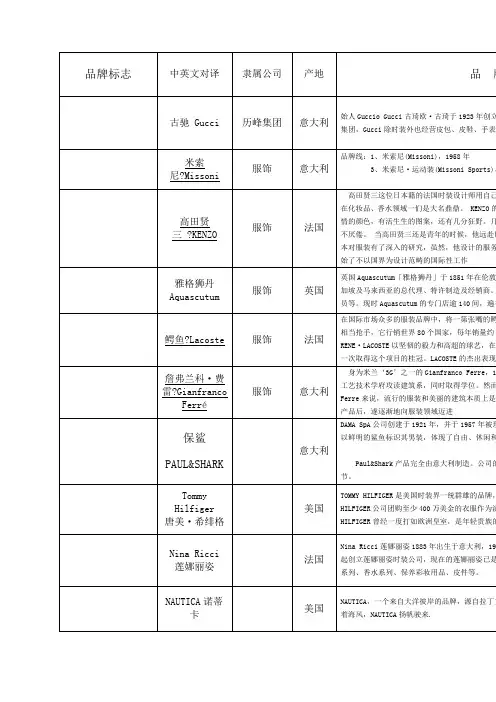
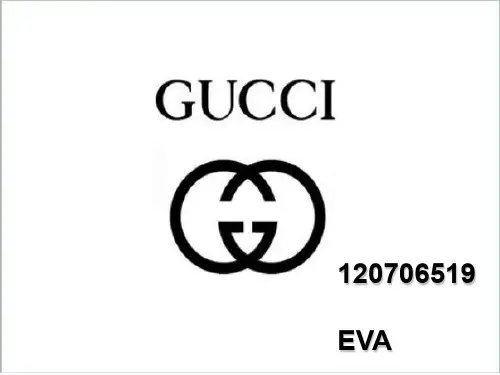
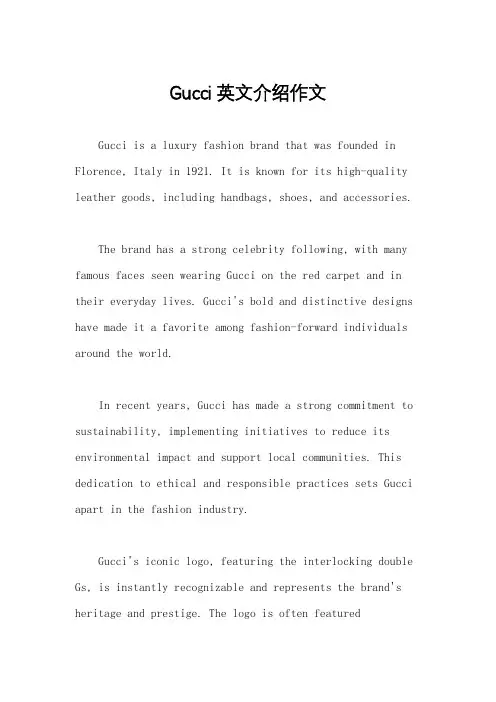
Gucci英文介绍作文Gucci is a luxury fashion brand that was founded in Florence, Italy in 1921. It is known for its high-quality leather goods, including handbags, shoes, and accessories.The brand has a strong celebrity following, with many famous faces seen wearing Gucci on the red carpet and in their everyday lives. Gucci's bold and distinctive designs have made it a favorite among fashion-forward individuals around the world.In recent years, Gucci has made a strong commitment to sustainability, implementing initiatives to reduce its environmental impact and support local communities. This dedication to ethical and responsible practices sets Gucci apart in the fashion industry.Gucci's iconic logo, featuring the interlocking double Gs, is instantly recognizable and represents the brand's heritage and prestige. The logo is often featuredprominently on its products, serving as a symbol of luxury and sophistication.Gucci's creative director, Alessandro Michele, has brought a fresh and eclectic vision to the brand, reimagining its classic designs with a modern twist. His bold and innovative approach has garnered widespread acclaim and kept Gucci at the forefront of fashion trends.Gucci's diverse range of products caters to a wide range of tastes and styles, from classic and timeless pieces to bold and avant-garde creations. Whether you're looking for a statement accessory or a wardrobe staple, Gucci has something to offer for every fashion enthusiast.。
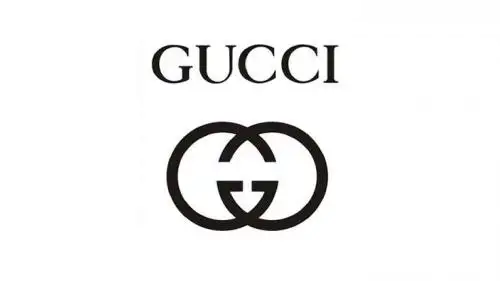
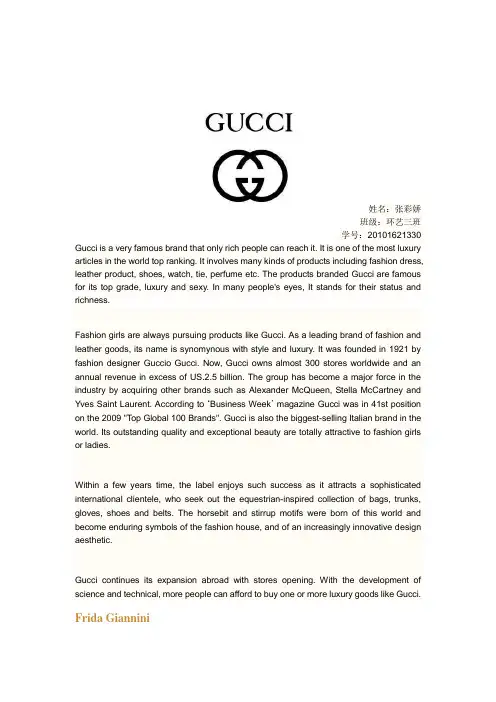
姓名:张彩娇班级:环艺三班学号:20101621330 Gucci is a very famous brand that only rich people can reach it. It is one of the most luxury articles in the world top ranking. It involves many kinds of products including fashion dress, leather product, shoes, watch, tie, perfume etc. The products branded Gucci are famous for its top grade, luxury and sexy. In many people's eyes, It stands for their status and richness.Fashion girls are always pursuing products like Gucci. As a leading brand of fashion and leather goods, its name is synomynous with style and luxury. It was founded in 1921 by fashion designer Guccio Gucci. Now, Gucci owns almost 300 stores worldwide and an annual revenue in excess of US.2.5 billion. The group has become a major force in the industry by acquiring other brands such as Alexander McQueen, Stella McCartney and Yves Saint Laurent. According to ‘Business Week’ magazine Gucci was in 41st position on the 2009 "Top Global 100 Brands". Gucci is also the biggest-selling Italian brand in the world. Its outstanding quality and exceptional beauty are totally attractive to fashion girls or ladies.Within a few years time, the label enjoys such success as it attracts a sophisticated international clientele, who seek out the equestrian-inspired collection of bags, trunks, gloves, shoes and belts. The horsebit and stirrup motifs were born of this world and become enduring symbols of the fashion house, and of an increasingly innovative design aesthetic.Gucci continues its expansion abroad with stores opening. With the development of science and technical, more people can afford to buy one or more luxury goods like Gucci.Frida GianniniCreative Director of GucciFrida Giannini's unique talent and passionate disposition has fuelled her rise as an international designer for one of the most recognized luxury fashion brands.Born in Rome in 1972, she studied fashion design at Rome's Fashion Academy before apprenticing in a small ready to wear house. In 1997, she landed a job at Fendi where she worked as a ready to wear designer for three seasons before being named designer for Fendi leather goods. In September 2002, she joined Gucci as Handbag Design Director. Two years later, she was appointed to the unprecedented role of Creative Director of Accessories in charge of bags, shoes, luggage, small leather goods, silks, fine jewelry, gifts, watches and eyewear. She took on the position with her trademark confidence and conviction, and has brought a powerful point-of-view to the house's accessories.By reinterpreting iconic elements from Gucci's past, such as the "Flora" scarf patterns and equestrian imagery, she has infused a rich heritage with new energy and modern sex appeal.In March 2005, she was named Creative Director of Gucci Women's ready-to-wear, in addition to her responsibilities for all accessories. In January 2006, she also became in charge of men's wear, thus becoming the sole Creative Director of the label. Her fresh and joyous vision combined with her savvy interpretation of the Gucci legacy has delighted fashion followers around the world. She has also been embraced by Hollywood, where her designs frequently grace the red carpet.Frida approaches her life as passionately as she does work. Her humor, intelligence and fine-tuned aesthetic instincts shine through all of her designs. She has the same appreciation for a 1950s Raphael arm chair as she does for a new wave David Bowie album cover.Through her frequent travels she constantly expands her range of inspirations and cultural experiences. Her well-rounded lifestyle makes her appreciate the needs of the modern Gucci woman. She balances the demands of a brilliant career with the laughter and intimacy of family and friends. Crediting her warm and optimistic personality to the sunny Roman way of life, Frida is a true embodiment of Italian style.Like the brand she designs for, Frida has chosen to base in Florence both her professional and private life. She works in Gucci's offices in the town and resides with her husband in a 15th century apartment in the centre of Florence.History1920sIn 1921, Guccio Gucci opens a leather goods company and small luggage store in his native Florence. Having spent years working in London's Savoy Hotel, he had absorbed the refined aesthetic of English nobility, and introduces this sensibility in Italy through exclusive leather goods created and produced by the master craftsmanship of Tuscan artisans.1930sWithin a few years time, the label enjoys such success as it attracts a sophisticated international clientele, who seek out the equestrian-inspired collection of bags, trunks, gloves, shoes and belts. The horsebit and stirrup motifs were born of this world and become enduring symbols of the fashion house, and of an increasingly innovative design aesthetic.1940sFaced with a shortage of standard materials during the difficult years of Fascist dictatorship in Italy, Gucci establishes itself as an enterprise synonymous with exceptional creativity and resourcefulness. The "Bamboo Bag" is introduced, becoming one of the first of Gucci's many iconic products. A favorite of royalty and celebrity alike, the bag is still available today.1950sDuring the 1950s, the trademark green-red-green web, which is derived from the saddle girth, becomes a great success and remains one of the most familiar identifiers of the brand. With stores opening in Milan and New York, Gucci starts to build a global presence as a symbol of modern luxury.Guccio Gucci dies in 1953. His sons Aldo, V asco, Ugo and Rodolfo take over the business. 1960sGucci introduces products that are cherished by the most iconic figures of the time and become renown for timeless design. Jackie Kennedy carries the Gucci shoulder bag, which is known today as the ‘Jackie O’. Liz Taylor, Peter Sellers and Samuel Beckett wear the unstructured, unisex 'Hobo Bag.' The classic moccasin with horsebit hardware becomes part of the permanent collection at the Costume Institute, Metropolitan Museum of Art in New York. The Flora silk print scarf is created for Grace Kelly.Gucci continues its expansion abroad with stores opening in London, Palm Beach, Paris and Beverly Hills.In the mid 60s, Gucci adopts the legendary interlocking double 'G' logo.1970sGucci continues its global expansion, true to the original aspirations of Aldo, now targeting the Far East. Stores open in Tokyo and Hong Kong. The company increases and diversifies production, carrying out significant research on new more luxurious materials and innovative approaches to design never tabling the legendary quality and craftsmanship synonymous with the brand. The great classics are revamped in new shapes and colors, and new product categories are introduced. 1980sIn 1982, Gucci becomes a public limited company, and leadership is passed to Rodolfo's son, Maurizio Gucci, who holds 50 percent of the shares. In 1984, Domenico De Sole becomes president of Gucci America. Investcorp, a Bahrain-based investment company, purchases the remaining 50 percent belonging to Aldo Gucci and his descendants in the late 80s.1990sGucci is relaunched to global renown through a groundbreaking mix of tradition and innovation. Tom Ford becomes creative director of Gucci in 1994 and infuses the luxury brand with a sense of daring and provocation that resonates with celebrity and accomplished elite. The stiletto, and silk cut-out jersey dresses with metallic hardware details become icons of Ford's unique vision. Domenico De Sole is appointed CEO in 1995, and Gucci makes the highly successful transformation to a fully public company. Gucci is named "European Company of the year 1998" by the European Business Press Federation for its economic and financial performance, strategic vision and management quality. In 1999, Gucci enters into a strategic alliance with Pinault-Printemps-Redoute and transforms itself from a single brand company into a multibrand group.2000sAfter De Sole and Ford left their posts in 2004, Mark Lee is appointed President and CEO of Gucci division in 2005. Today, creative direction of Gucci is the responsibility of Frida Giannini and Gucci continues to explore its roots. "La Pelle Guccissima" - an entirely original, heat-printed signature leather - has been launched under Giannini’s directio n, and is destined to become the label's next icon, expressing in its workmanship and impeccable quality a strength that is singularly Gucci's.Gucci Gucci by GucciGucci by Gucci is a 450-page tour through our history and tradition. It is a celebration of the commitment to luxury and style, which has made the Gucci name synonymous with Italian craftsmanship, outstanding quality and exceptional beauty.The book tells the story of our brand through photographs of our iconic products and the celebrities whose passion for Gucci have enhanced the brand image throughout our history. Many of these photographs have never been published before.A special limited edition version of the Gucci by Gucci book, featuring a slipcase in "La Pelle Guccissima," will be sold at Gucci boutiques.。
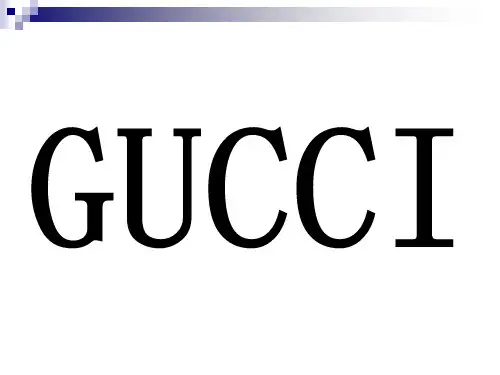
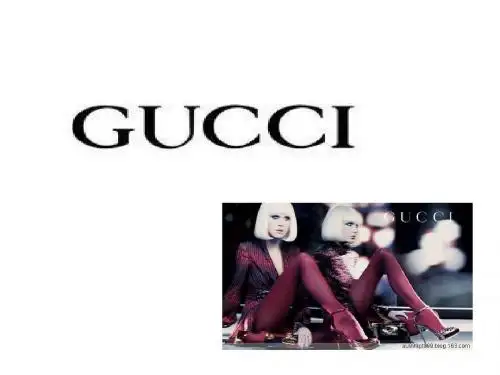
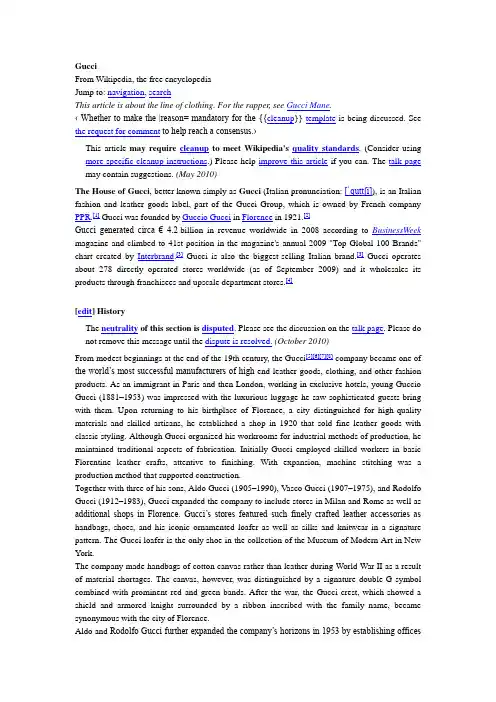
GucciFrom Wikipedia, the free encyclopediaJump to: navigation, searchThis article is about the line of clothing. For the rapper, see Gucci Mane.‹ Whether to make the |reason= mandatory for the {{cleanup}} template is being discussed. See the request for comment to help reach a consensus.›This article may require cleanup to meet Wikipedia's quality standards. (Consider using more specific cleanup instructions.) Please help improve this article if you can. The talk page may contain suggestions. (May 2010)The House of Gucci, better known simply as Gucci(Italian pronunciation: [ˈɡuttʃi]), is an Italian fashion and leather goods label, part of the Gucci Group, which is owned by French company PPR.[1] Gucci was founded by Guccio Gucci in Florence in 1921.[2]Gucci generated circa € 4.2 billion in revenue worldwide in 2008 according to BusinessWeek magazine and climbed to 41st position in the magazine's annual 2009 "Top Global 100 Brands" chart created by Interbrand.[3]Gucci is also the biggest-selling Italian brand.[3]Gucci operates about 278 directly operated stores worldwide (as of September 2009) and it wholesales its products through franchisees and upscale department stores.[4][edit] HistoryThe neutrality of this section is disputed. Please see the discussion on the talk page. Please do not remove this message until the dispute is resolved.(October 2010)From modest beginnings at the end of the 19th century, the Gucci[5][6][7][8] company became one of the world’s most successful manufacturers of high-end leather goods, clothing, and other fashion products. As an immigrant in Paris and then London, working in exclusive hotels, young Guccio Gucci (1881–1953) was impressed with the luxurious luggage he saw sophisticated guests bring with them. Upon returning to his birthplace of Florence, a city distinguished for high-quality materials and skilled artisans, he established a shop in 1920 that sold fine leather goods with classic styling. Although Gucci organized his workrooms for industrial methods of production, he maintained traditional aspects of fabrication. Initially Gucci employed skilled workers in basic Florentine leather crafts, attentive to finishing. With expansion, machine stitching was a production method that supported construction.Together with three of his sons, Aldo Gucci (1905–1990), Vasco Gucci (1907–1975), and Rodolfo Gucci (1912–1983), Gucci expanded the company to include stores in Milan and Rome as well as additional shops in Florence. Gucci’s stores featured such finely crafted leather accessories as handbags, shoes, and his iconic ornamented loafer as well as silks and knitwear in a signature pattern. The Gucci loafer is the only shoe in the collection of the Museum of Modern Art in New York.The company made handbags of cotton canvas rather than leather during World War II as a result of material shortages. The canvas, however, was distinguished by a signature double-G symbol combined with prominent red and green bands. After the war, the Gucci crest, which showed a shield and armored knight surrounded by a ribbon inscribed with the family name, became synonymous with the city of Florence.Aldo and Rodolfo Gucci further expanded the company’s horizons in 1953 by establishing officesin New York City. Film stars and jet-set travelers to Italy during the 1950s and 1960s brought their glamour to Florence, turning Gucci’s merchandise into international status symbols. Movie stars posed in Gucci’s clothing, accessories, and footwear for lifestyle magazines around the world, contributing to the company’s growing reputation.Gucci shop on Strøget in Copenhagen, DenmarkGucci’s distinctive lines made its products among the most frequently copied in the world in the early 2000s. Pigskin, calf, and imported exotic animal skins were subjected to various methods of fabrication. Waterproof canvas and satin were used for evening bags. Bamboo was first used to make handbag handles by a process of heating and molding in 1947, and purses made with a shoulder strap and snaffle-bit decoration were introduced in 1960. In 1964 Gucci’s lush butterfly pattern was custom-created for silk foulards, followed by equally luxuriant floral patterns. The original Gucci loafer was updated by a distinctive snaffle-bit ornament in 1966, while the ―Rolls-Royce‖ luggage set was introduced in 1970. Watches, jewelry, ti es, and eyewear were then added to the company’s product lines. A particularly iconic touch, introduced in 1964, was the use of the double-G logo for belt buckles and other accessory decorations.[9]The company prospered through the 1970s, but the 1980s were marked by internal family disputes that brought Gucci to the brink of disaster. Rodolfo’s son Maurizio took over the company’s direction after his father’s death in 1983, and dismi ssed his uncle Aldo—who eventually served a prison term for tax evasion. Maurizio proved to be an unsuccessful president; he was compelled to sell the family-owned company to Investcorp, a Bahrain-based company, in 1988. Maurizio disposed of his remaining stock in 1993. Tragically, Maurizio was murdered in Milan in 1995, and his former wife, Patrizia Reggiani, was convicted of hiring his killers. Meanwhile, the new investors promoted the American-educated Domenico De Sole from the position of family attorney to president of Gucci America in 1994 and chief executive in 1995.The company had previously brought in Dawn Mello in 1989 as editor and ready-to-wear designer in order to reestablish its reputation. Well aware of Gucci’s tarnished image and the value o f its name brand, Mello hired Tom Ford in 1990 to design a ready-to-wear line. He was promoted to the position of creative director in 1994. Before Mello returned to her post as president of the American retailer Bergdorf Goodman, she initiated the return of Gucci’s headquarters from the business center of Milan to Florence, where its craft traditions were rooted. There she and Ford reduced the number of Gucci products from twenty thousand to a more reasonable five thousand. There were seventy-six Gucci stores around the world in 1997, along with numerous licensing agreements. Ford was instrumental in the process of decision-making with De Sole when the Gucci Group acquired Yves Saint Laurent Rive Gauche, Bottega Veneta, Boucheron, Sergio Rossi, and, in part-ownership with Stella McCartney, Alexander McQueen and Balenciaga. By 2001 Ford and De Sole shared the responsibility for major business decisions, while Ford concurrently directed design at Yves Saint Laurent as well as at Gucci.The French conglomerate Pinault-Printemps-Redoute, however, gained ownership of 60 percent of the Gucci Group’s stock in 2003. Women’s Wear Daily then announced the departure of both Domenico De Sole and Tom Ford from the Gucci Group when their contracts expired in April 2004. The last spring collection under the direction of Ford and De Sole was a critical and commercial success. Amid widespread speculation in the fashion press about Ford’s heir, the company announced in March 2004 that he would be replaced by a team of younger designerspromoted from the ranks of the company’s staff.In 2005, Frida Giannini was appointed as the creati ve director for women’s ready-to-wear and accessories, previously joining Gucci in 2002. In 2006, she also became the creative director for men's ready-to-wear and the entire Gucci label.[10][edit] CorporateGucci store at nightA turnaround of the company devised in the late 1980s made Gucci a global contender and notable fashion label. In October 1995 Gucci went public and had its first initial public offering on the AMEX and NYSE for $22 per share. November 1997 also proved to be a successful year as Gucci acquired a watch licensee, Severin-Montres, and renamed it Gucci Timepieces. The firm was named "European Company of the Year 1998" by the European Business Press Federation for its economic and financial performance, strategic vision as well as management quality. Gucci world offices and headquarters are in Florence, Milan, Paris, London, Hong Kong, Japan, and New York. PPR headquarters are in Paris.[edit] New managementThis section appears to be written like an advertisement. Please help improve it by rewriting promotional content from a neutral point of view and removing any inappropriate external links. (June 2010)Gucci New Bag in 2011In 1989, Maurizio managed to persuade Dawn Mello, whose revival of New York's Bergdorf Goodman in the 1970s made her a star in the retail business, to join the newly formed Gucci Group as Executive Vice President and Creative Director Worldwide. At the helm of Gucci America was Domenico De Sole, a former lawye r who helped oversee Maurizio’s takeover of ten 1987 and 1989. The last addition to the creative team, which already included designers from Geoffrey Beene and Calvin Klein, was a young designer named Tom Ford.Raised in Texas and New Mexico, he had been interested in fashion since his early teens but only decided to pursue a career as a designer after dropping out of Parsons School of Design in 1986 as an architecture major. Dawn Mello hired Ford in 1990 at the urging of his partner, writer and editor Richard Buckley.In the early 1990s, Gucci underwent what is now recognized as the poorest time in the company's history. Maurizio riled distributors, Investcorp shareholders, and executives at Gucci America by drastically reining in on the sales of the Gucci Accessories Collection, which in the United States alone generated $110 million in revenue every year. The company’s new accessories failed to pick up the slack, and for the next three years the company experienced heavy losses and teetered on the edge of bankruptcy. Maurizio was a charming man who passionately loved his family's business, but after four years most of the company's senior managers agreed that he was incapable of running the company. His management had had an adverse effect on the desirability of the brand, product quality, and distribution control. He was forced to sell his shares in the company to Investcorp in August 1993. Dawn Mello returned to her job at Bergdorf Goodman less than a year after Mauriz io’s departure, and the position of creative director went to Tom Ford, then just 32 years old. Ford had worked for years under the direction of Maurizio and Mello and wanted to take the company’s image in a new direction. De Sole, who had been elevated to President andChief Executive Officer ofGucci Group NV, realized that if Gucci was to become a profitable company, it would require a new image, and so he agreed to pursue Ford’s vision.In early 1999 the luxury goods conglomerate LVMH, headed by Bernard Arnault, increased its shareholdings in Gucci with a view to a takeover. Domenico De Sole was incensed by the news and declined Arnault’s request for a spot on the board of directors, where he would have access to Gucci’s confidential earnings reports, strategy meetings, and design concepts. De Sole reacted by issuing new shares of stock in an effort to dilute the val ue of Arnault’s holdings. He also approached French holding company Pinault-Printemps-Redoute(PPR) about the possibility of forming a strategic alliance. Francois Pinault, the company’s founder, agreed to the idea and purchased 37 million shares in the company, or a 40% stake. Arnault’s share was diluted to a paltry 20%, and a legal battle ensued to challenge the legitimacy of the new Gucci-PPR partnership, with the law firm of Skadden, Arps, Slate, Meagher & Flom representing Gucci. Courts in the Netherlands ultimately upheld the PPR deal, as it did not violate that country's business laws. The second largest shareholder is Crédit Lyonnais with 11%. As of September 2001 a settlement agreement was put into place between Gucci Group, LVMH, and PPR.Following Ford's departure, Gucci Group retained three designers to continue the success of the company's flagship label: John Ray, Alessandra Facchinetti and Frida Giannini,[11]all of whom had worked under Ford's creative direction. Facchinetti was elevated to Creative Director of Womenswear in 2004 and designed for two seasons before leaving the company. Ray served as Creative Director of Menswear for three years. 32-year-old Giannini, who had been responsible for designing men's and women's accessories, currently serves as Creative Director for the entire brand.Frida Giannini, formerly Creative Director of accessories, is named sole Creative Director in 2006. In 2009, Patrizio di Marco replaces Mark Lee as CEO of Gucci.[edit] Children's lineGucci’s president and chief executive officer Patrizio di Marco revealed that Gucci is set to launch a children’s line in June 2010. The line will initially be unveiled in Italy and to 40 stores around the world. Frida Giannini serves as the creative director of the line. Giannini has been applauded on her fresh, feminine take on contemporary fashion. Born in Rome in 1972 to an architect father and art history professor mother she studied fashion design at Rome's Fashion Academy. Once she completed her education she went on to apprentice at a small-scale fashion house. In 1997 Giannini began a career at fashion house Fendi, where after just three seasons of designing for ready-to-wear she was promoted to designer of leather goods. In 2002 she moved to Gucci as director of handbags, and in 2004 was promoted to designer of all accessories. A year later in 2005 the designer was promoted to creative director of women's ready-to-wear at Gucci, in addition to her role as designer of accessories. In 2006 Giannini was named creative director of the label when she became responsible for design of menswear. In addition to clothing design, she has also developed retail concepts for Gucci stores, and creative control of advertising.[edit] Automobile cultureThe interior of the AMC Hornet Sportabout with the Gucci package[edit] American Motors CorporationAldo Gucci expanded into new markets including an agreement with American Motors Corporation (AMC). The automaker merged the worlds of couture and automobiles with the GucciAMC Hornet.[12]Starting in October 1971,[13]the 1972 and 1973 model year Hornet compact "Sportabout" station wagons became one of the first American cars to offer a special luxury trim package created by a famous fashion designer.[14] Although coming from Italy where sleek sports cars are more revered, Gucci put his special touch efforts on the Hornet station wagon with a a rear lift gate and60.8 cubic feet (1,722 l) of cargo space inside.[15] The Gucci versions came with the designer's signature red and green trim colors on well-padded beige-upholstered seating and on the interior door panels. The Gucci crest appeared on the inside front door panels and on the front fenders, while the "GG" trademark was on the headliner. Exterior color selections were limited to Snow White, Hunter Green, Grasshopper Green, and Yuca Tan.[16]General MotorsIn 1979 and 1980, a Miami-based aftermarket company offered the Cadillac Seville by Gucci edition. The exterior included a "facing double G" Gucci logo, an emblem actually featuring Guccio Gucci’s initials,[9] as a hood ornament and the c-pillar covered vinyl roof. The interior had a headliner of the logo and headrests adorned with the logo as well. The dashboard carried the "Gucci script" logo in bold lettering. Inside the trunk was a full set of Gucci luggage.Ford Motor CompanyA 1989 Gucci Series Lincoln Town Car was scheduled to be offered, per pricing guides, but never came to fruition. Lincoln offered Emilio Pucci, Bill Blass, Gianni Versace, Hubert de Givenchy, and Valentino designer editions during the 1970s and 1980s.FiatFor 2011, marking the celebration of both the 150th anniversary of the unification of Italy and Gucci's 90th anniversary, Gucci and Fiat unveiled the special edition 500 by Gucci. Available in two versions; Black and White. The black version has detailing in shiny chrome with an interior that contrasts sharp black and white for a contemporary and racy feel, whilst the white version complete with satin chrome detailing and ivory and black interior creates a softer look PartnershipsGucci has had a partnership with UNICEF since 2005.[17]Gucci stores worldwide donate a percentage of the sales for special collections made specifically for UNICEF to go toward the United Nations Children's Fund. The annual Gucci Campaign to Benefit UNICEF supports education, healthcare, protection and clean water programs for orphans and children affected by HIV/AIDS in sub-Saharan Africa. For the campaign in 2009, Michael Roberts promoted a children's book, "Snowman in Africa" with proceeds going to UNICEF. In five years, Gucci donated over $7 million to UNICEF. Gucci is the largest corporate donor to UNICEF's "Schools for Africa" that was established in 2004 by UNICEF, the Nelson Mandela Foundation, and the Hamburg Society. Its goal is to increase access to basic schooling for all, with a special emphasis on children orphaned by HIV/AIDS and children living in extreme poverty.RecordIn 1998 Guinness World Records cited the Gucci "Genius Jeans" as the most expensive pair of jeans in existence. These jeans were distressed, ripped and covered with African beads and were offered for sale for US$3,134 in Milan.[18]This record has since been surpassed in June 2005 by Levi Strauss & Co.'s 115-year-old 501 jeans that was sold to an anonymous Japanese collector for $60,000.[19]。
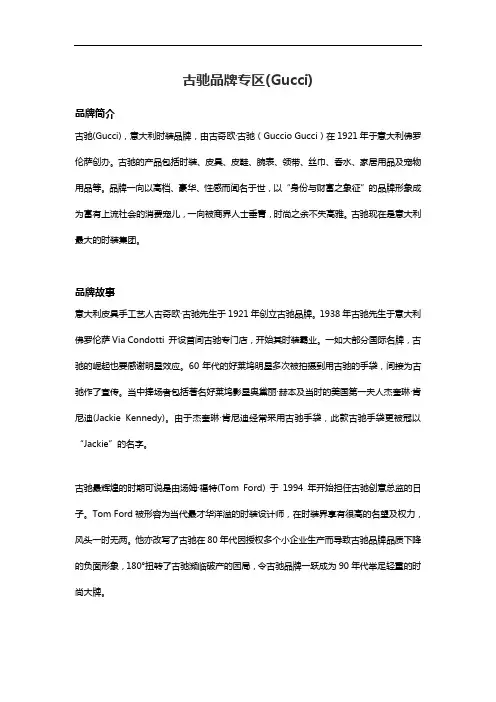
古驰品牌专区(Gucci)品牌简介古驰(Gucci),意大利时装品牌,由古奇欧·古驰(Guccio Gucci)在1921年于意大利佛罗伦萨创办。
古驰的产品包括时装、皮具、皮鞋、腕表、领带、丝巾、香水、家居用品及宠物用品等。
品牌一向以高档、豪华、性感而闻名于世,以“身份与财富之象征”的品牌形象成为富有上流社会的消费宠儿,一向被商界人士垂青,时尚之余不失高雅。
古驰现在是意大利最大的时装集团。
品牌故事意大利皮具手工艺人古奇欧·古驰先生于1921年创立古驰品牌。
1938年古驰先生于意大利佛罗伦萨Via Condotti 开设首间古驰专门店,开始其时装霸业。
一如大部分国际名牌,古驰的崛起也要感谢明星效应。
60年代的好莱坞明星多次被拍摄到用古驰的手袋,间接为古驰作了宣传。
当中捧场者包括著名好莱坞影星奥黛丽·赫本及当时的美国第一夫人杰奎琳·肯尼迪(Jackie Kennedy)。
由于杰奎琳·肯尼迪经常采用古驰手袋,此款古驰手袋更被冠以“Jackie”的名字。
古驰最辉煌的时期可说是由汤姆·福特(Tom Ford) 于1994年开始担任古驰创意总监的日子。
Tom Ford被形容为当代最才华洋溢的时装设计师,在时装界享有很高的名望及权力,风头一时无两。
他亦改写了古驰在80年代因授权多个小企业生产而导致古驰品牌品质下降的负面形象,180°扭转了古驰濒临破产的困局,令古驰品牌一跃成为90年代举足轻重的时尚大牌。
汤姆·福特创新地采用优质高科技面料设计古驰时装,领导了时装界对布料要求的新方向。
汤姆·福特在职期间曾多次引领时尚界潮流,令古驰与时尚划上等号。
如95年古驰秋冬时装秀,名模Kate Moss在T台上以一身古驰天鹅绒低腰裤及丝质衬衫,配衬粗黑眼线的look,迅速成为国际明星名人模仿的对象。
而汤姆·福特于2004年4月宣布离职的消息轰动了整个时装界,当时曾有人认为古驰皇朝从此结束。
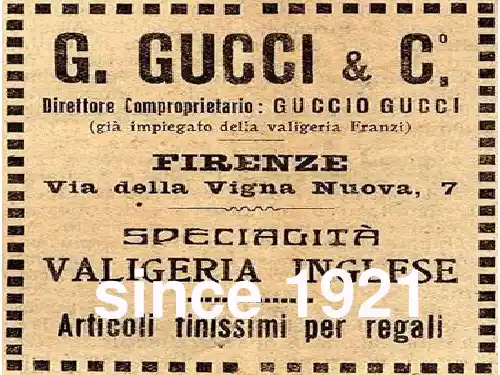
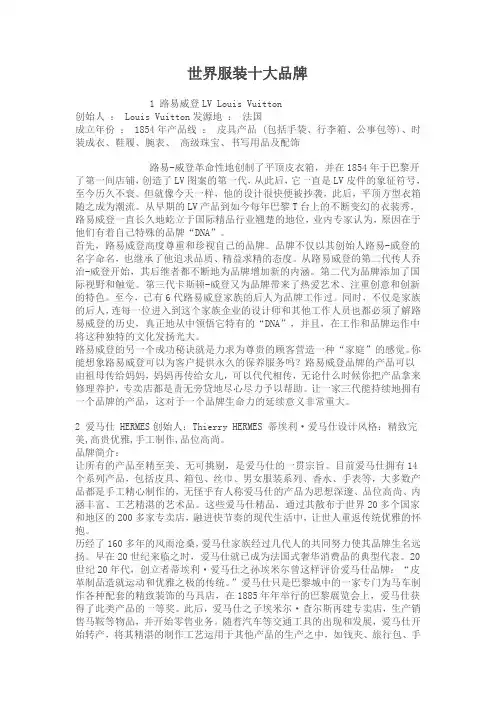
世界服装十大品牌1 路易威登LV Louis Vuitton创始人: Louis Vuitton发源地:法国成立年份: 1854年产品线:皮具产品 (包括手袋、行李箱、公事包等)、时装成衣、鞋履、腕表、高级珠宝、书写用品及配饰路易-威登革命性地创制了平顶皮衣箱,并在1854年于巴黎开了第一间店铺,创造了LV图案的第一代,从此后,它一直是LV皮件的象征符号,至今历久不衰。
但就像今天一样,他的设计很快便被抄袭,此后,平顶方型衣箱随之成为潮流。
从早期的LV产品到如今每年巴黎T台上的不断变幻的衣装秀,路易威登一直长久地屹立于国际精品行业翘楚的地位,业内专家认为,原因在于他们有着自己特殊的品牌“DNA”。
首先,路易威登高度尊重和珍视自己的品牌。
品牌不仅以其创始人路易-威登的名字命名,也继承了他追求品质、精益求精的态度。
从路易威登的第二代传人乔治-威登开始,其后继者都不断地为品牌增加新的内涵。
第二代为品牌添加了国际视野和触觉。
第三代卡斯顿-威登又为品牌带来了热爱艺术、注重创意和创新的特色。
至今,已有6代路易威登家族的后人为品牌工作过。
同时,不仅是家族的后人,连每一位进入到这个家族企业的设计师和其他工作人员也都必须了解路易威登的历史,真正地从中领悟它特有的“DNA”,并且,在工作和品牌运作中将这种独特的文化发扬光大。
路易威登的另一个成功秘诀就是力求为尊贵的顾客营造一种“家庭”的感觉。
你能想象路易威登可以为客户提供永久的保养服务吗?路易威登品牌的产品可以由祖母传给妈妈,妈妈再传给女儿,可以代代相传,无论什么时候你把产品拿来修理养护,专卖店都是责无旁贷地尽心尽力予以帮助。
让一家三代能持续地拥有一个品牌的产品,这对于一个品牌生命力的延续意义非常重大。
2 爱马仕 HERMES创始人:Thierry HERMES 蒂埃利·爱马仕设计风格:精致完美,高贵优雅,手工制作,品位高尚。
品牌简介:让所有的产品至精至美、无可挑剔,是爱马仕的一贯宗旨。
Gucci◆古琦(GUCCI) 品牌档案:中文名:古琦,曾用“古驰”做中文名。
也有译为“古奇”、“古姿”。
英文名:GUCCI国家:意大利创建年代:1906年创建人:古驰欧·古驰(GUCCIo GUCCI) 先生GUCCI 设计师:自Tom Ford 离去之后,Alessandra Fachinetti 曾短暂的担任过GUCCI 设计师,仅2季之后,就换为意大利设计师弗里达·贾娜妮(Frida Giannini),一直至今。
设计风格:奢华、性感、夸耀、带一丝丝摇滚味道◆古琦(GUCCI) 品牌识别和品牌LOGO :1. 竹节手柄:优雅的GUCCI竹节手柄包,取材于大自然,所有的竹子都从中国及越南进口,大自然材料以及手工烧烤技术成就其不易断裂的特点。
2. 马术链:在20世纪初的意大利马匹是主要代步工具,因此制造马具的人比较多,GUCCI 是其中的佼佼者。
系着马匹的马术链也是GUCCI的发明。
这个著名的细节设计,除了因为美观,也是对过去马术时代的一个缅怀。
GUCCI镶有马术链的麂皮休闲鞋已是鞋类历史上的一个典范,连美国的大都会博物馆都收藏了一双。
3. 著名的“双G”Logo及醒目的红与绿色作为GUCCI的象征出现在包包、手袋、钱包等GUCCI产品上,这也是GUCCI最早的经典LOGO设计。
◆古琦(GUCCI) 品牌介绍:古琦(GUCCI) 是意大利殿堂级时尚品牌。
GUCCI 是意大利语,标准中文名为“古琦”,曾用“古驰”做中文名,也有译为“古奇”、“古姿”。
古琦集团(GUCCI Group) 是全球最著名的奢侈品集团,古琦集团(GUCCI Group) 总部位于意大利弗罗伦萨,经营高级男女时装、香水、包包皮具、鞋履、手表、家居饰品、宠物用品等昂贵的奢侈品。
古琦(GUCCI) 品牌作为古琦集团(GUCCI Group) 最享有盛名的时装品牌,以高档、豪华、性感而闻名于世,古琦(GUCCI) 的“双G”logo,以“身份与财富之象征”的品牌形象,成为富有的上流社会的消费宠儿。
GUCCI(古琦)简介
·类型:高级成衣·创始人:古奇欧·古琦注册地:意大利佛罗伦萨(1923年)设计师:1923年-1989年,古奇欧·古琦1989年-1992年,Richardmbertson(理查德·兰伯森),时装设计兼创意指导1990年-1991年,DawnMello(唐·梅洛),美国籍设计师1994年,TomFord(汤姆·福特)
品牌线:Gucci古琦品类:服装、皮包皮鞋、手表、家饰品、宠物用品、丝巾与领带,1975年,成立古驰香水部,推出香水产品。
目标消费群:上层社会妇女,影星地址:73ViaTornabuoni,Florence,lTALY品牌传奇
自Karl Lagerfeld接管Chanel以来,最吸引人最令人震惊的要算是TomFord接手Gucci的故事了。
在1994年Tom Ford被任命为创意总监之前,Gucci家族已经由于经营管理不善而陷入困境濒临破产……
时尚必备:古琦尽管时装牌子令人眼花缭乱,GUCCI的风格却一向被商界人士垂青,时尚之余不失高雅,这个意大利牌子的服饰一直以简单设计为主,尤其是今季的男装,剪裁新颖,弥漫着十八世纪威尼期风情,再融入牛仔、太空和摇滚巨星的色彩,让豪迈中带点不羁,散发无穷魅力。
古琦(GUCCI)王国的当代传奇
在GUCCI的时尚王国中,有最受全球媒体宠爱、年轻又才华洋溢的设计师Tom Ford,更有包括麦当娜、玛莉亚凯莉、葛妮斯派特罗、伊丽莎白赫莉、布莱德彼特,还有汤姆汉克斯夫妇等阵容最坚强的影星死忠爱用者。
品牌标志中英文对译隶属公司产地品牌简介古驰 Gucci 历峰集团意大利始人Guccio Gucci古琦欧·古琦于1923年创立Gucci。
位于佛罗伦萨的Gucci集团是当今意大利最大时装集团,Gucci除时装外也经营皮包、皮鞋、手表、家饰品、宠物用品、丝巾、领带、皮带、香水等。
米索尼Missoni 服饰意大利品牌线:1、米索尼(Missoni),1958年 2、米索尼·尤莫(Missoni Uomo),1985年3、米索尼·运动装(Missoni Sports),1985年针织系列为世界顶级产品高田贤三KENZO 服饰法国高田贤三这位日本籍的法国时装设计师用自己的名贤三命名的KENZO品牌,已经不仅仅是时装业的精品,在化妆品、香水领域一们是大名鼎鼎。
KENZO的时装不是那种标新立异的拔高,它有一点点传统,有许多热情的颜色,有活生生的图案,还有几分狂野。
几乎每一款都能找到实际穿着的场合,但吸引力之强却使你绝不厌倦。
当高田贤三还是青年的时候,他远赴巴黎开始他的国际时装设计师生涯,他有备而来,已经在日本对服装有了深入的研究,虽然,他设计的服务对象从东方人转为西方人,但丝毫没有碍障,而从此,他开始了不以国界为设计范畴的国际性工作雅格狮丹Aquascutum 服饰英国英国Aquascutum「雅格狮丹」于1851年在伦敦创立。
YGM贸易于1998年成为Aquascutum大中华地区、星加坡及马来西亚的总代理、特许制造及经销商。
品牌专走高档路线,顾客对象是企业家、专业人士及行政人员等。
现时Aquascutum的专门店逾140间,遍布香港、澳门、台湾及中国各大小城市。
鳄鱼Lacoste 服饰法国在国际市场众多的服装品牌中,将一第张嘴的鳄鱼绣在上衣左胸前的服装最引人注目,虽然其售价不菲,但相当抢手,它行销世界80个国家,每年销量约2500万套(件)。
上个世纪30年代初期,法国网球名将RENE·LACOSTE以坚韧的毅力和高超的球艺,在一次国际锦标赛中击败当时称雄世界的美国选手,为法国第一次取得这个项目的桂冠。
姓名:张彩娇班级:环艺三班学号:20101621330 Gucci is a very famous brand that only rich people can reach it. It is one of the most luxury articles in the world top ranking. It involves many kinds of products including fashion dress, leather product, shoes, watch, tie, perfume etc. The products branded Gucci are famous for its top grade, luxury and sexy. In many people's eyes, It stands for their status and richness.Fashion girls are always pursuing products like Gucci. As a leading brand of fashion and leather goods, its name is synomynous with style and luxury. It was founded in 1921 by fashion designer Guccio Gucci. Now, Gucci owns almost 300 stores worldwide and an annual revenue in excess of US.2.5 billion. The group has become a major force in the industry by acquiring other brands such as Alexander McQueen, Stella McCartney and Yves Saint Laurent. According to ‘Business Week’ magazine Gucci was in 41st position on the 2009 "Top Global 100 Brands". Gucci is also the biggest-selling Italian brand in the world. Its outstanding quality and exceptional beauty are totally attractive to fashion girls or ladies.Within a few years time, the label enjoys such success as it attracts a sophisticated international clientele, who seek out the equestrian-inspired collection of bags, trunks, gloves, shoes and belts. The horsebit and stirrup motifs were born of this world and become enduring symbols of the fashion house, and of an increasingly innovative design aesthetic.Gucci continues its expansion abroad with stores opening. With the development of science and technical, more people can afford to buy one or more luxury goods like Gucci.Frida GianniniCreative Director of GucciFrida Giannini's unique talent and passionate disposition has fuelled her rise as an international designer for one of the most recognized luxury fashion brands.Born in Rome in 1972, she studied fashion design at Rome's Fashion Academy before apprenticing in a small ready to wear house. In 1997, she landed a job at Fendi where she worked as a ready to wear designer for three seasons before being named designer for Fendi leather goods. In September 2002, she joined Gucci as Handbag Design Director. Two years later, she was appointed to the unprecedented role of Creative Director of Accessories in charge of bags, shoes, luggage, small leather goods, silks, fine jewelry, gifts, watches and eyewear. She took on the position with her trademark confidence and conviction, and has brought a powerful point-of-view to the house's accessories.By reinterpreting iconic elements from Gucci's past, such as the "Flora" scarf patterns and equestrian imagery, she has infused a rich heritage with new energy and modern sex appeal.In March 2005, she was named Creative Director of Gucci Women's ready-to-wear, in addition to her responsibilities for all accessories. In January 2006, she also became in charge of men's wear, thus becoming the sole Creative Director of the label. Her fresh and joyous vision combined with her savvy interpretation of the Gucci legacy has delighted fashion followers around the world. She has also been embraced by Hollywood, where her designs frequently grace the red carpet.Frida approaches her life as passionately as she does work. Her humor, intelligence and fine-tuned aesthetic instincts shine through all of her designs. She has the same appreciation for a 1950s Raphael arm chair as she does for a new wave David Bowie album cover.Through her frequent travels she constantly expands her range of inspirations and cultural experiences. Her well-rounded lifestyle makes her appreciate the needs of the modern Gucci woman. She balances the demands of a brilliant career with the laughter and intimacy of family and friends. Crediting her warm and optimistic personality to the sunny Roman way of life, Frida is a true embodiment of Italian style.Like the brand she designs for, Frida has chosen to base in Florence both her professional and private life. She works in Gucci's offices in the town and resides with her husband in a 15th century apartment in the centre of Florence.History1920sIn 1921, Guccio Gucci opens a leather goods company and small luggage store in his native Florence. Having spent years working in London's Savoy Hotel, he had absorbed the refined aesthetic of English nobility, and introduces this sensibility in Italy through exclusive leather goods created and produced by the master craftsmanship of Tuscan artisans.1930sWithin a few years time, the label enjoys such success as it attracts a sophisticated international clientele, who seek out the equestrian-inspired collection of bags, trunks, gloves, shoes and belts. The horsebit and stirrup motifs were born of this world and become enduring symbols of the fashion house, and of an increasingly innovative design aesthetic.1940sFaced with a shortage of standard materials during the difficult years of Fascist dictatorship in Italy, Gucci establishes itself as an enterprise synonymous with exceptional creativity and resourcefulness. The "Bamboo Bag" is introduced, becoming one of the first of Gucci's many iconic products. A favorite of royalty and celebrity alike, the bag is still available today.1950sDuring the 1950s, the trademark green-red-green web, which is derived from the saddle girth, becomes a great success and remains one of the most familiar identifiers of the brand. With stores opening in Milan and New York, Gucci starts to build a global presence as a symbol of modern luxury.Guccio Gucci dies in 1953. His sons Aldo, V asco, Ugo and Rodolfo take over the business. 1960sGucci introduces products that are cherished by the most iconic figures of the time and become renown for timeless design. Jackie Kennedy carries the Gucci shoulder bag, which is known today as the ‘Jackie O’. Liz Taylor, Peter Sellers and Samuel Beckett wear the unstructured, unisex 'Hobo Bag.' The classic moccasin with horsebit hardware becomes part of the permanent collection at the Costume Institute, Metropolitan Museum of Art in New York. The Flora silk print scarf is created for Grace Kelly.Gucci continues its expansion abroad with stores opening in London, Palm Beach, Paris and Beverly Hills.In the mid 60s, Gucci adopts the legendary interlocking double 'G' logo.1970sGucci continues its global expansion, true to the original aspirations of Aldo, now targeting the Far East. Stores open in Tokyo and Hong Kong. The company increases and diversifies production, carrying out significant research on new more luxurious materials and innovative approaches to design never tabling the legendary quality and craftsmanship synonymous with the brand. The great classics are revamped in new shapes and colors, and new product categories are introduced. 1980sIn 1982, Gucci becomes a public limited company, and leadership is passed to Rodolfo's son, Maurizio Gucci, who holds 50 percent of the shares. In 1984, Domenico De Sole becomes president of Gucci America. Investcorp, a Bahrain-based investment company, purchases the remaining 50 percent belonging to Aldo Gucci and his descendants in the late 80s.1990sGucci is relaunched to global renown through a groundbreaking mix of tradition and innovation. Tom Ford becomes creative director of Gucci in 1994 and infuses the luxury brand with a sense of daring and provocation that resonates with celebrity and accomplished elite. The stiletto, and silk cut-out jersey dresses with metallic hardware details become icons of Ford's unique vision. Domenico De Sole is appointed CEO in 1995, and Gucci makes the highly successful transformation to a fully public company. Gucci is named "European Company of the year 1998" by the European Business Press Federation for its economic and financial performance, strategic vision and management quality. In 1999, Gucci enters into a strategic alliance with Pinault-Printemps-Redoute and transforms itself from a single brand company into a multibrand group.2000sAfter De Sole and Ford left their posts in 2004, Mark Lee is appointed President and CEO of Gucci division in 2005. Today, creative direction of Gucci is the responsibility of Frida Giannini and Gucci continues to explore its roots. "La Pelle Guccissima" - an entirely original, heat-printed signature leather - has been launched under Giannini’s directio n, and is destined to become the label's next icon, expressing in its workmanship and impeccable quality a strength that is singularly Gucci's.Gucci Gucci by GucciGucci by Gucci is a 450-page tour through our history and tradition. It is a celebration of the commitment to luxury and style, which has made the Gucci name synonymous with Italian craftsmanship, outstanding quality and exceptional beauty.The book tells the story of our brand through photographs of our iconic products and the celebrities whose passion for Gucci have enhanced the brand image throughout our history. Many of these photographs have never been published before.A special limited edition version of the Gucci by Gucci book, featuring a slipcase in "La Pelle Guccissima," will be sold at Gucci boutiques.。